1. Doody EE, Groebner JL, Walker JR, Frizol BM, Tuma DJ, Fernandez DJ, Tuma PL. 2017; Ethanol metabolism by alcohol dehydrogenase or cytochrome P450 2E1 differentially impairs hepatic protein trafficking and growth hormone signaling. Am J Physiol Gastrointest Liver Physiol. 313:G558–G569. DOI:
10.1152/ajpgi.00027.2017. PMID:
28864499. PMCID:
PMC5814672.
2. Siegmund SV, Dooley S, Brenner DA. 2005; Molecular mechanisms of alcohol-induced hepatic fibrosis. Dig Dis. 23:264–274. DOI:
10.1159/000090174. PMID:
16508291.

3. Goedde HW, Agarwal DP. 1981; [Alcohol metabolizing enzymes: biochemical properties, genetic heterogeneity and their possible role in alcohol metabolism in humans (author's transl)]. J Clin Chem Clin Biochem. 19:179–189. German.
4. Li CJ, Nanji AA, Siakotos AN, Lin RC. 1997; Acetaldehyde-modified and 4-hydroxynonenal-modified proteins in the livers of rats with alcoholic liver disease. Hepatology. 26:650–657. DOI:
10.1002/hep.510260317. PMID:
9303495.

5. Sapkota M, Hottor TK, DeVasure JM, Wyatt TA, McCaskill ML. 2014; Protective role of CYP2E1 inhibitor diallyl disulfide (DADS) on alcohol-induced malondialdehyde-deoxyguanosine (M1dG) adduct formation. Alcohol Clin Exp Res. 38:1550–1558. DOI:
10.1111/acer.12439. PMID:
24891074. PMCID:
PMC4049196.

6. Niemelä O, Parkkila S, Ylä-Herttuala S, Halsted C, Witztum JL, Lanca A, Israel Y. 1994; Covalent protein adducts in the liver as a result of ethanol metabolism and lipid peroxidation. Lab Invest. 70:537–546.
7. Kundu R, Dasgupta S, Biswas A, Bhattacharya A, Pal BC, Bandyopadhyay D, Bhattacharya S, Bhattacharya S. 2008; Cajanus cajan Linn. (Leguminosae) prevents alcohol-induced rat liver damage and augments cytoprotective function. J Ethnopharmacol. 118:440–447. DOI:
10.1016/j.jep.2008.05.010. PMID:
18584980.

9. Kojima H, Sakurai S, Uemura M, Takekawa T, Morimoto H, Tamagawa Y, Fukui H. 2005; Difference and similarity between non-alcoholic steatohepatitis and alcoholic liver disease. Alcohol Clin Exp Res. 29(12 Suppl):259S–263S. DOI:
10.1097/01.alc.0000191776.37626.30. PMID:
16385233.

10. McCullough RL, McMullen MR, Sheehan MM, Poulsen KL, Roychowdhury S, Chiang DJ, Pritchard MT, Caballeria J, Nagy LE. 2018; Complement factor D protects mice from ethanol-induced inflammation and liver injury. Am J Physiol Gastrointest Liver Physiol. 315:G66–G79. DOI:
10.1152/ajpgi.00334.2017. PMID:
29597356. PMCID:
PMC6109707.

11. Canbay A, Friedman S, Gores GJ. 2004; Apoptosis: the nexus of liver injury and fibrosis. Hepatology. 39:273–278. DOI:
10.1002/hep.20051. PMID:
14767974.

12. Han Y, Xu Q, Hu JN, Han XY, Li W, Zhao LC. 2015; Maltol, a food flavoring agent, attenuates acute alcohol-induced oxidative damage in mice. Nutrients. 7:682–696. DOI:
10.3390/nu7010682. PMID:
25608939. PMCID:
PMC4303861.
13. Sun X, Wang P, Yao LP, Wang W, Gao YM, Zhang J, Fu YJ. 2018; Paeonol alleviated acute alcohol-induced liver injury
via SIRT1/Nrf2/NF-κB signaling pathway. Environ Toxicol Pharmacol. 60:110–117. DOI:
10.1016/j.etap.2018.04.016. PMID:
29704732.
14. Jang HS, Um SI, Lee SH, Whang WK, Min YS, Park SY, Sohn UD. 2017; The protective mechanism of QGC in feline esophageal epithelial cells by interleukin-1β treatment. Arch Pharm Res. 40:204–213. DOI:
10.1007/s12272-016-0858-x. PMID:
28012047.

15. Nageen B, Sarfraz I, Rasul A, Hussain G, Rukhsar F, Irshad S, Riaz A, Selamoglu Z, Ali M. 2020; Eupatilin: a natural pharmacologically active flavone compound with its wide range applications. J Asian Nat Prod Res. 22:1–16. DOI:
10.1080/10286020.2018.1492565. PMID:
29973097.

16. Kim JS, Lee SG, Min K, Kwon TK, Kim HJ, Nam JO. 2018; Eupatilin inhibits adipogenesis through suppression of PPARγ activity in 3T3-L1 cells. Biomed Pharmacother. 103:135–139. DOI:
10.1016/j.biopha.2018.03.073. PMID:
29649628.

17. Kim M, Min YS, Sohn UD. 2018; Cytoprotective effect of eupatilin against indomethacin-induced damage in feline esophageal epithelial cells: relevance of HSP27 and HSP70. Arch Pharm Res. 41:1019–1031. DOI:
10.1007/s12272-018-1066-7. PMID:
30109575.

18. Ryoo SB, Oh HK, Yu SA, Moon SH, Choe EK, Oh TY, Park KJ. 2014; The effects of eupatilin (stillen®) on motility of human lower gastrointestinal tracts. Korean J Physiol Pharmacol. 18:383–390. DOI:
10.4196/kjpp.2014.18.5.383. PMID:
25352757. PMCID:
PMC4211121.

19. Choi EJ, Oh HM, Na BR, Ramesh TP, Lee HJ, Choi CS, Choi SC, Oh TY, Choi SJ, Chae JR, Kim SW, Jun CD. 2008; Eupatilin protects gastric epithelial cells from oxidative damage and down-regulates genes responsible for the cellular oxidative stress. Pharm Res. 25:1355–1364. DOI:
10.1007/s11095-008-9531-5. PMID:
18299966.

20. Yoo BM, Oh TY, Kim YB, Yeo M, Lee JS, Surh YJ, Ahn BO, Kim WH, Sohn S, Kim JH, Hahm KB. 2005; Novel antioxidant ameliorates the fibrosis and inflammation of cerulein-induced chronic pancreatitis in a mouse model. Pancreatology. 5:165–176. DOI:
10.1159/000085268. PMID:
15849487.

21. Zhou K, Cheng R, Liu B, Wang L, Xie H, Zhang C. 2018; Eupatilin ameliorates dextran sulphate sodium-induced colitis in mice partly through promoting AMPK activation. Phytomedicine. 46:46–56. DOI:
10.1016/j.phymed.2018.04.033. PMID:
30097122.

22. Oh TY, Lee JS, Ahn BO, Cho H, Kim WB, Kim YB, Surh YJ, Cho SW, Hahm KB. 2001; Oxidative damages are critical in pathogenesis of reflux esophagitis: implication of antioxidants in its treatment. Free Radic Biol Med. 30:905–915. DOI:
10.1016/S0891-5849(01)00472-5. PMID:
11295533.

23. Ryu BK, Ahn BO, Oh TY, Kim SH, Kim WB, Lee EB. 1998; Studies on protective effect of DA-9601, Artemisia asiatica extract, on acetaminophen- and CCl4-induced liver damage in rats. Arch Pharm Res. 21:508–513. DOI:
10.1007/BF02975366. PMID:
9875486.
24. Park SC, Yoon JH, Kim W, Gwak GY, Kim KM, Lee SH, Lee SM, Lee HS. 2006; Eupatilin attenuates bile acid-induced hepatocyte apoptosis. J Gastroenterol. 41:772–778. DOI:
10.1007/s00535-006-1854-6. PMID:
16988766.

25. Parvez MK, Arbab AH, Al-Dosari MS, Al-Rehaily AJ, Alam P, Ibrahim KE, Alsaid MS, Rafatullah S. 2018; Protective effect of Atriplex suberecta extract against oxidative and apoptotic hepatotoxicity. Exp Ther Med. 15:3883–3891. DOI:
10.3892/etm.2018.5919. PMID:
29581744. PMCID:
PMC5863606.
26. Kim D, Kim GW, Lee SH, Han GD. 2016; Ligularia fischeri extract attenuates liver damage induced by chronic alcohol intake. Pharm Biol. 54:1465–1473. DOI:
10.3109/13880209.2015.1104701. PMID:
26799831.
27. Yu K, Li XM, Xu XL, Zhang RY, Cong HL. 2015; Eupatilin protects against tumor necrosis factor-α-mediated inflammation inhuman umbilical vein endothelial cells. Int J Clin Exp Med. 8:22191–22197.
28. Qiao Z, Xu YW, Yang J. 2016; Eupatilin inhibits the apoptosis in H9c2 cardiomyocytes via the Akt/GSK-3β pathway following hypoxia/reoxygenation injury. Biomed Pharmacother. 82:373–378. DOI:
10.1016/j.biopha.2016.05.026. PMID:
27470375.

29. Wang X, Ren J, Zhu S, Ren G, Wang L, Chen X, Qiu Z, Zhang C. 2018; Pharmacokinetics and tissue distribution of eupatilin and its metabolite in rats by an HPLC-MS/MS method. J Pharm Biomed Anal. 159:113–118. DOI:
10.1016/j.jpba.2018.06.037. PMID:
29980012.

30. Adaramoye OA, Aluko A, Oyagbemi AA. 2011; Cnidoscolus aconitifolius leaf extract protects against hepatic damage induced by chronic ethanol administration in Wistar rats. Alcohol Alcohol. 46:451–458. DOI:
10.1093/alcalc/agr060. PMID:
21616948.

31. Araújo Júnior RF, Garcia VB, Leitão RF, Brito GA, Miguel Ede C, Guedes PM, de Araújo AA. 2016; Carvedilol improves inflammatory response, oxidative stress and fibrosis in the alcohol-induced liver injury in rats by regulating Kuppfer cells and hepatic stellate cells. PLoS One. 11:e0148868. DOI:
10.1371/journal.pone.0148868. PMID:
26891124. PMCID:
PMC4758650.

32. Liu R, Chen QH, Ren JW, Sun B, Cai XX, Li D, Mao RX, Wu X, Li Y. 2018; Ginseng (Panax ginseng Meyer) oligopeptides protect against binge drinking-induced liver damage through inhibiting oxidative stress and inflammation in rats. Nutrients. 10:1665. DOI:
10.3390/nu10111665. PMID:
30400371. PMCID:
PMC6266439.

33. Ilaiyaraja N, Khanum F. 2011; Amelioration of alcohol-induced hepatotoxicity and oxidative stress in rats by Acorus calamus. J Diet Suppl. 8:331–345. DOI:
10.3109/19390211.2011.615805. PMID:
22432772.
35. Rejitha S, Prathibha P, Indira M. 2012; Amelioration of alcohol-induced hepatotoxicity by the administration of ethanolic extract of Sida cordifolia Linn. Br J Nutr. 108:1256–1263. DOI:
10.1017/S0007114511006568. PMID:
22289614.
36. Hsieh YL, Yeh YH, Lee YT, Huang CY. 2015; Protective effects of Cholestin on ethanol induced oxidative stress in rats. J Sci Food Agric. 95:799–808. DOI:
10.1002/jsfa.6904. PMID:
25200286.

37. Huang H, Lin Z, Zeng Y, Lin X, Zhang Y. 2019; Probiotic and glutamine treatments attenuate alcoholic liver disease in a rat model. Exp Ther Med. 18:4733–4739. DOI:
10.3892/etm.2019.8123.

38. Zhou J, Zhang J, Wang C, Qu S, Zhu Y, Yang Z, Wang L. 2018; Açaí (Euterpe oleracea Mart.) attenuates alcohol-induced liver injury in rats by alleviating oxidative stress and inflammatory response. Exp Ther Med. 15:166–172. DOI:
10.3892/etm.2017.5427.

39. Lee IS, Park S, Park K, Choue R. 2011; Hepatoprotective activity of scutellariae radix extract in mice fed a high fat diet with chronic alcohol exposure. Phytother Res. 25:1348–1353. DOI:
10.1002/ptr.3370. PMID:
21341335.

40. Radosavljević T, Mladenović D, Vucević D. 2009; [The role of oxidative stress in alcoholic liver injury]. Med Pregl. 62:547–553. Serbian. DOI:
10.2298/MPNS0912547R. PMID:
20491381.

41. Cai Z, Shi T, Zhuang R, Fang H, Jiang X, Shao Y, Zhou H. 2018; Protective effect of N-acetylcysteine activated carbon release microcapsule on myocardial ischemia-reperfusion injury in rats. Exp Ther Med. 15:1809–1818. DOI:
10.3892/etm.2017.5653. PMID:
29434769. PMCID:
PMC5776512.

42. Zhang C, Shi S. 2018; Physiological and proteomic responses of contrasting alfalfa (
Medicago sativa L.) varieties to PEG-induced osmotic stress. Front Plant Sci. 9:242. DOI:
10.3389/fpls.2018.00242. PMID:
29541085. PMCID:
PMC5835757.

43. Turan A, Celik I. 2016; Antioxidant and hepatoprotective properties of dried fig against oxidative stress and hepatotoxicity in rats. Int J Biol Macromol. 91:554–559. DOI:
10.1016/j.ijbiomac.2016.06.009. PMID:
27268385.

44. Ma J, Li M, Kalavagunta PK, Li J, He Q, Zhang Y, Ahmad O, Yin H, Wang T, Shang J. 2018; Protective effects of cichoric acid on H2O
2-induced oxidative injury in hepatocytes and larval zebrafish models. Biomed Pharmacother. 104:679–685. DOI:
10.1016/j.biopha.2018.05.081. PMID:
29803928.
45. Muller FL, Song W, Liu Y, Chaudhuri A, Pieke-Dahl S, Strong R, Huang TT, Epstein CJ, Roberts LJ 2nd, Csete M, Faulkner JA, Van Remmen H. 2006; Absence of CuZn superoxide dismutase leads to elevated oxidative stress and acceleration of age-dependent skeletal muscle atrophy. Free Radic Biol Med. 40:1993–2004. DOI:
10.1016/j.freeradbiomed.2006.01.036. PMID:
16716900.

46. García-Niño WR, Zatarain-Barrón ZL, Hernández-Pando R, Vega-García CC, Tapia E, Pedraza-Chaverri J. 2015; Oxidative stress markers and histological analysis in diverse organs from rats treated with a hepatotoxic dose of Cr(VI): effect of curcumin. Biol Trace Elem Res. 167:130–145. DOI:
10.1007/s12011-015-0283-x. PMID:
25774041.

47. Deng Y, Xu Z, Xu B, Liu W, Feng S, Yang T. 2014; Antioxidative effects of schidandrin B and green tea polyphenols against mercuric chloride-induced hepatotoxicity in rats. J Environ Pathol Toxicol Oncol. 33:349–361. DOI:
10.1615/JEnvironPatholToxicolOncol.2014011859. PMID:
25404381.

48. Perdices L, Fuentes-Broto L, Segura F, Ben Gdara N, Sánchez-Cano AI, Insa G, Orduna E, Pinilla I. 2018; Hepatic oxidative stress in pigmented P23H rhodopsin transgenic rats with progressive retinal degeneration. Free Radic Biol Med. 124:550–557. DOI:
10.1016/j.freeradbiomed.2018.07.005. PMID:
30006118.

49. Li YG, Ji DF, Chen S, Hu GY. 2008; Protective effects of sericin protein on alcohol-mediated liver damage in mice. Alcohol Alcohol. 43:246–253. DOI:
10.1093/alcalc/agm164. PMID:
18263900.

50. Mallikarjuna K, Shanmugam KR, Nishanth K, Wu MC, Hou CW, Kuo CH, Reddy KS. 2010; Alcohol-induced deterioration in primary antioxidant and glutathione family enzymes reversed by exercise training in the liver of old rats. Alcohol. 44:523–529. DOI:
10.1016/j.alcohol.2010.07.004. PMID:
20705416.

51. Park SW, Oh TY, Kim YS, Sim H, Park SJ, Jang EJ, Park JS, Baik HW, Hahm KB. 2008; Artemisia asiatica extracts protect against ethanol-induced injury in gastric mucosa of rats. J Gastroenterol Hepatol. 23:976–984. DOI:
10.1111/j.1440-1746.2008.05333.x. PMID:
18444990.

52. Joo M, Kim HS, Kwon TH, Palikhe A, Zaw TS, Jeong JH, Sohn UD. 2015; Anti-inflammatory effects of flavonoids on TNBS-induced colitis of rats. Korean J Physiol Pharmacol. 19:43–50. DOI:
10.4196/kjpp.2015.19.1.43. PMID:
25605996. PMCID:
PMC4297761.

53. Palenski TL, Sorenson CM, Sheibani N. 2013; Inflammatory cytokine-specific alterations in retinal endothelial cell function. Microvasc Res. 89:57–69. DOI:
10.1016/j.mvr.2013.06.007. PMID:
23806781. PMCID:
PMC3764503.

54. Lin HZ, Yang SQ, Zeldin G, Diehl AM. 1998; Chronic ethanol consumption induces the production of tumor necrosis factor-alpha and related cytokines in liver and adipose tissue. Alcohol Clin Exp Res. 22(5 Suppl):231S–237S. DOI:
10.1111/j.1530-0277.1998.tb04008.x.

55. Kim YD, Lee KM, Hwang SL, Chang HW, Kim KJ, Harris RA, Choi HS, Choi WS, Lee SE, Park CS. 2015; Inhibition of cereblon by fenofibrate ameliorates alcoholic liver disease by enhancing AMPK. Biochim Biophys Acta. 1852:2662–2670. DOI:
10.1016/j.bbadis.2015.09.014. PMID:
26410577.

56. Zhang Y, Wang C, Yu B, Jiang JD, Kong WJ. 2018; Gastrodin protects against ethanol-induced liver injury and apoptosis in HepG2 cells and animal models of alcoholic liver disease. Biol Pharm Bull. 41:670–679. DOI:
10.1248/bpb.b17-00825. PMID:
29709905.

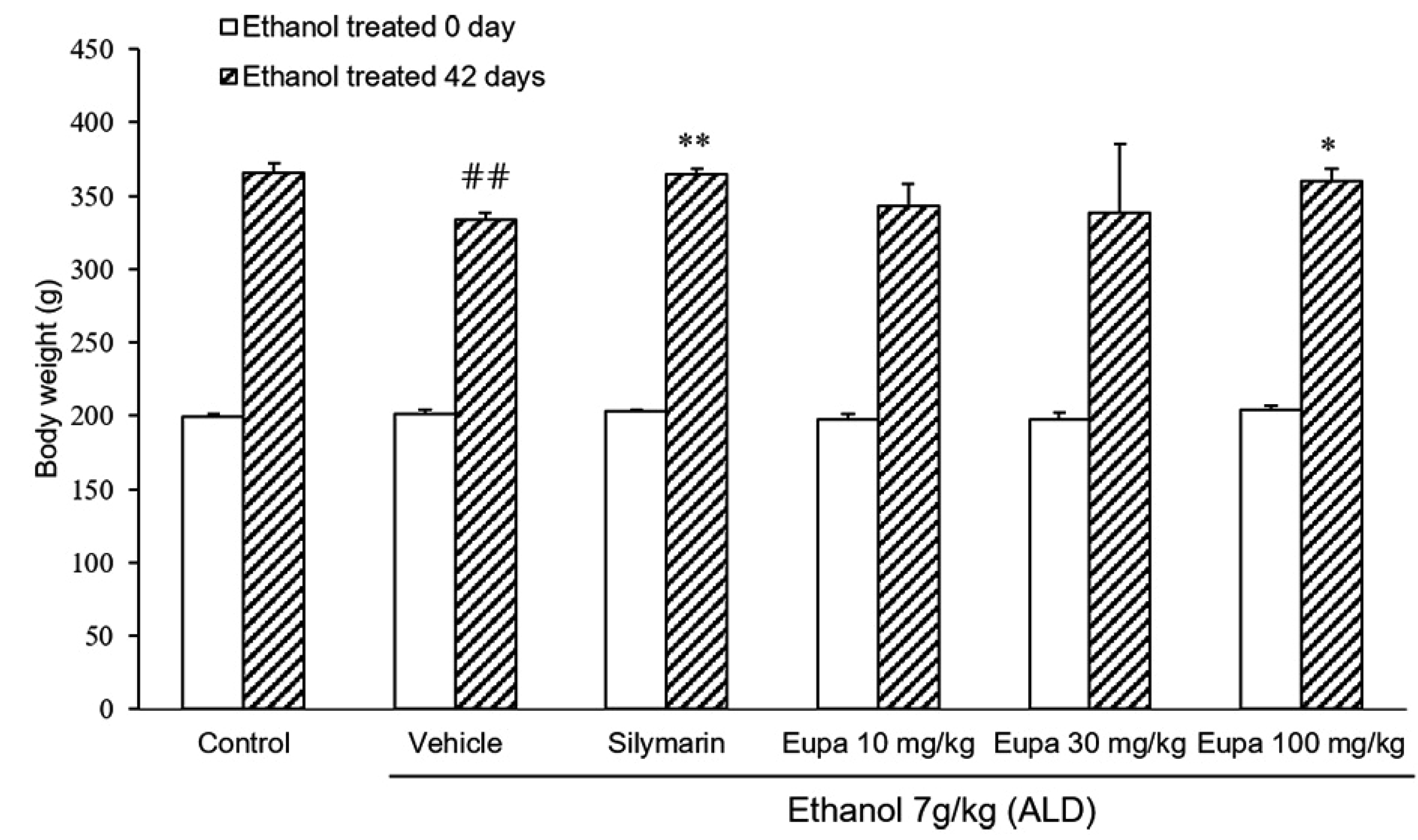
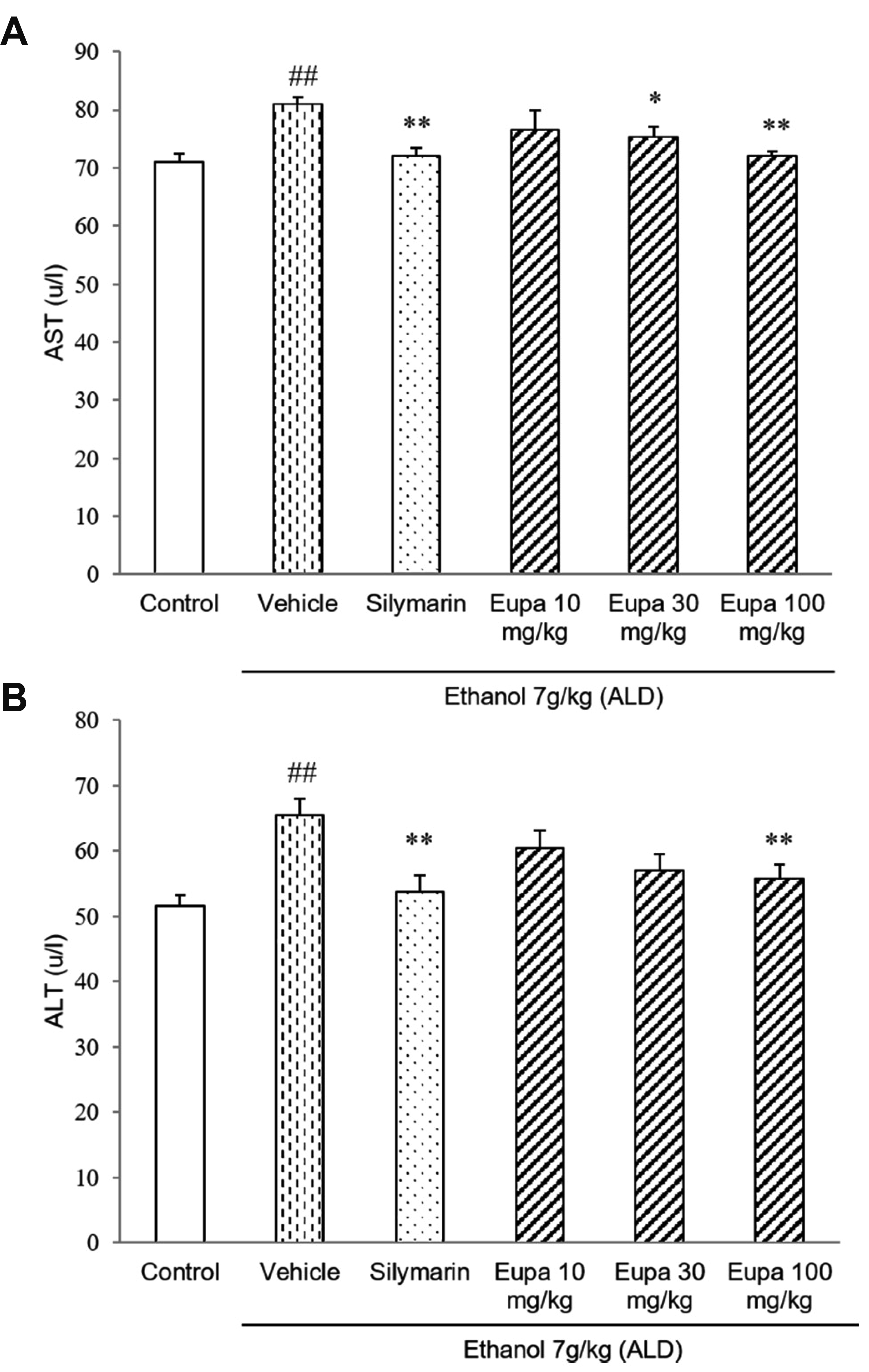
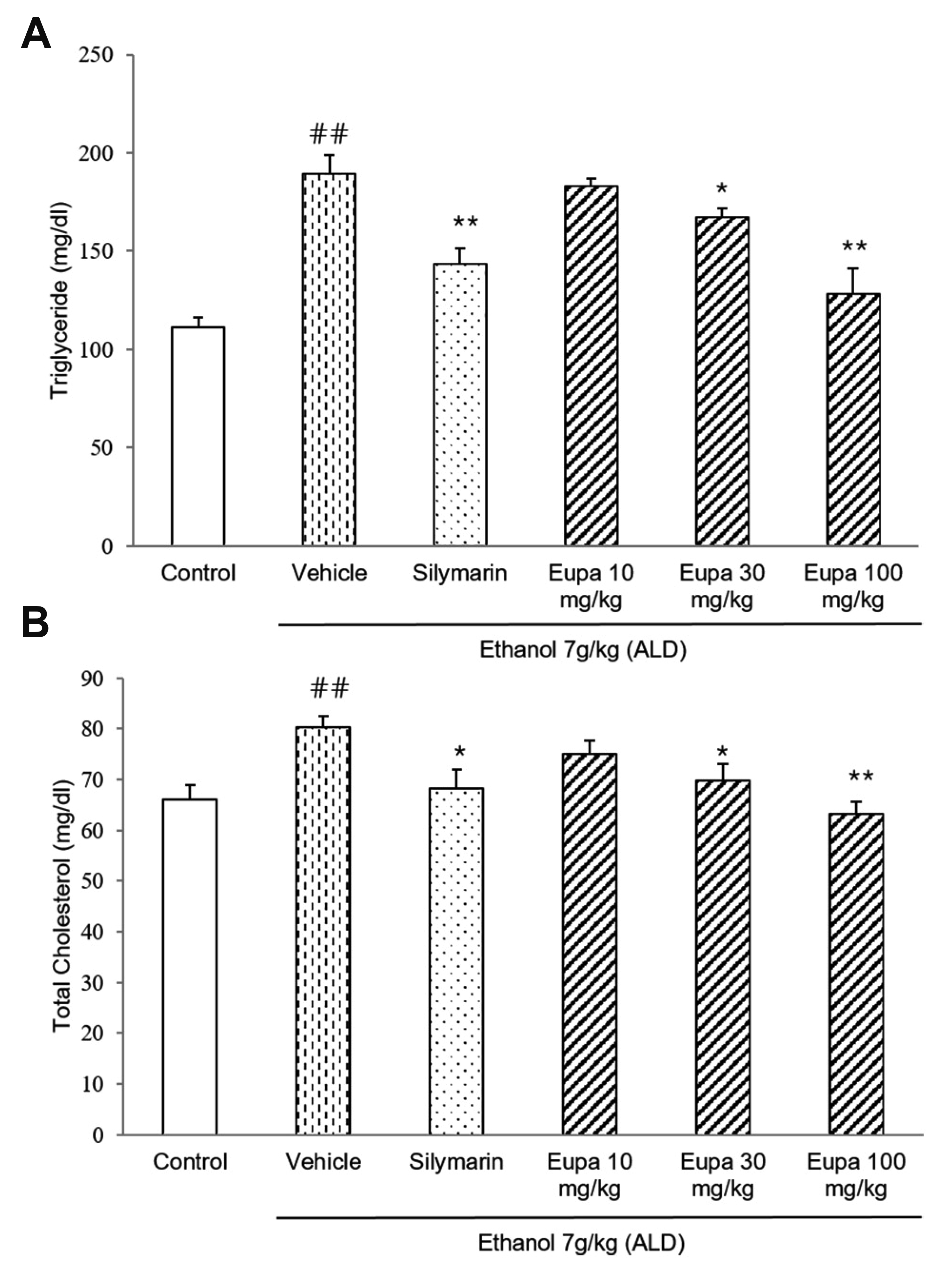
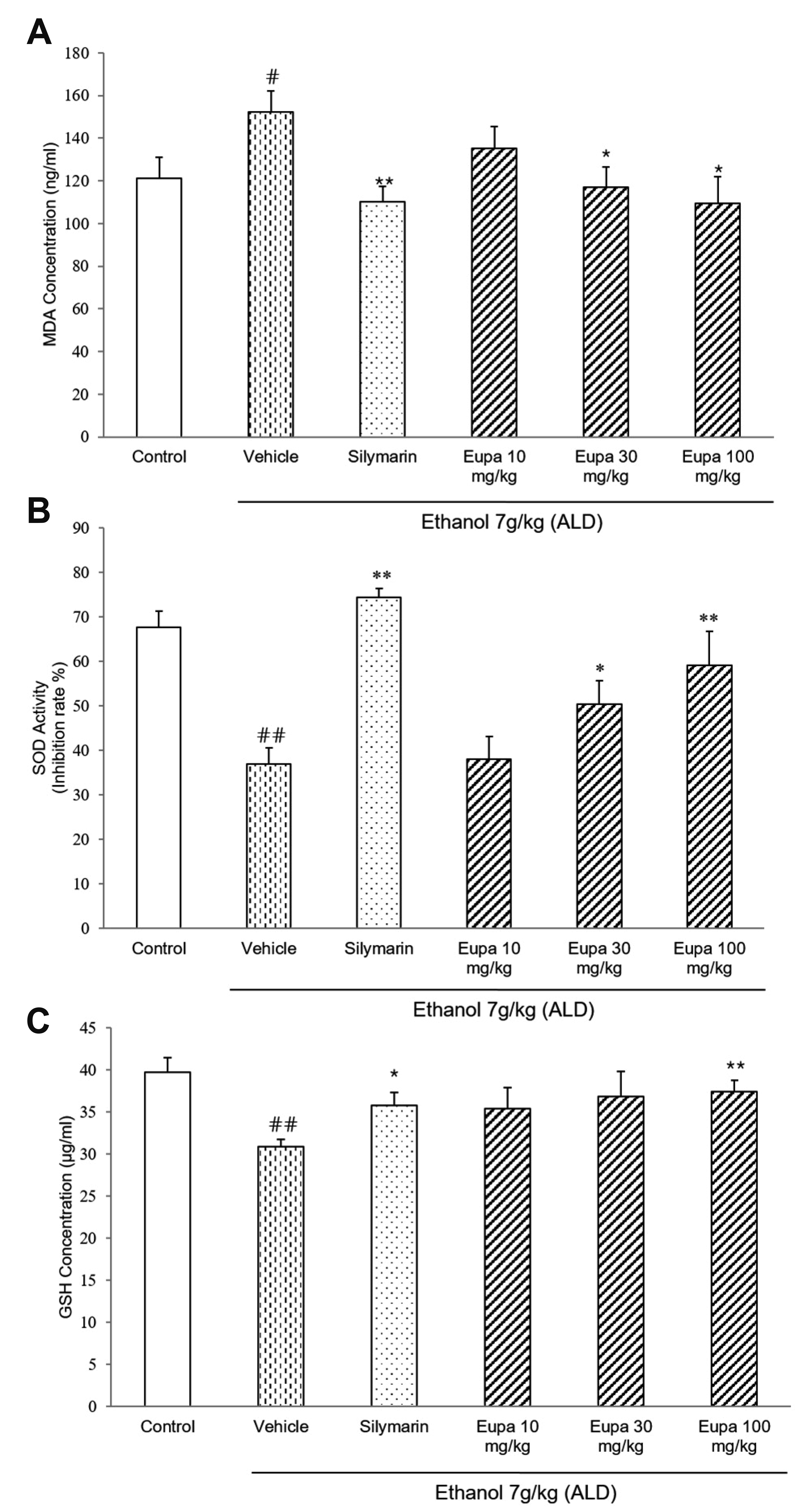
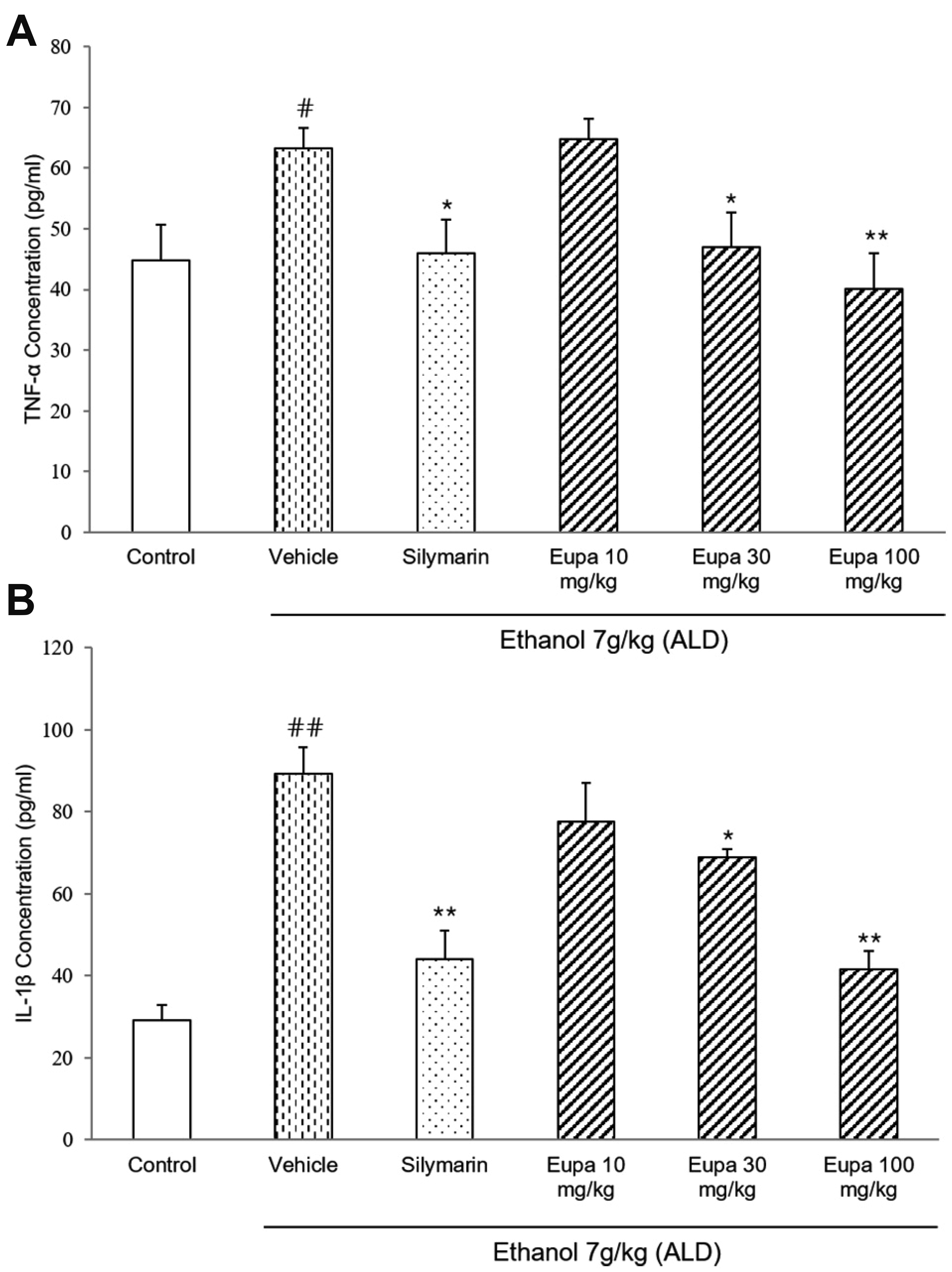





 PDF
PDF Citation
Citation Print
Print


 XML Download
XML Download